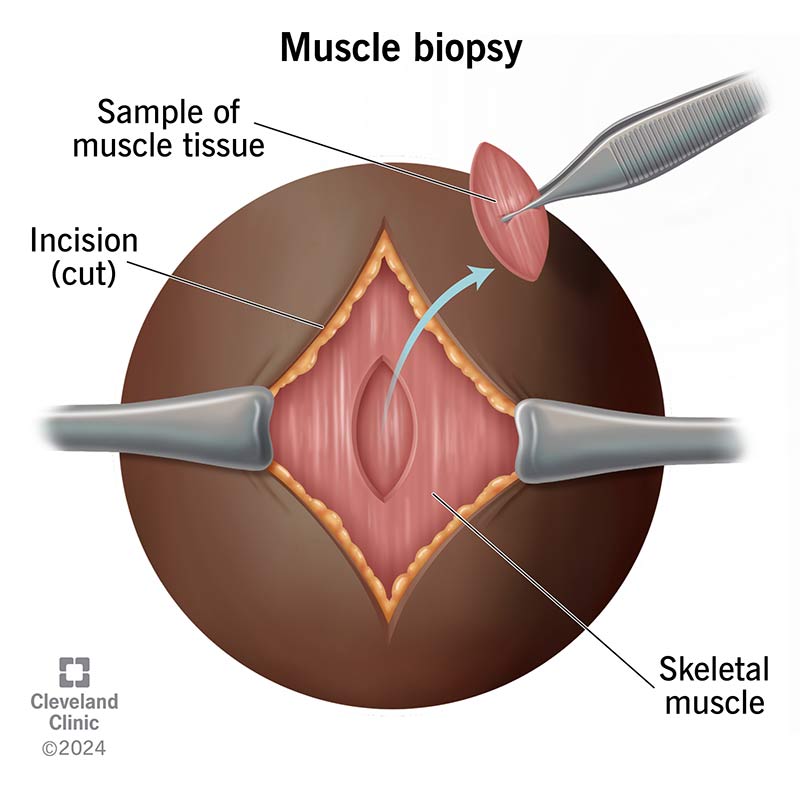A muscle biopsy may be part of your diagnosis journey if your healthcare provider suspects your weakness and other muscle-related symptoms are due to an underlying muscle condition. There are two main types — an open biopsy and a needle biopsy.
Advertisement
Cleveland Clinic is a non-profit academic medical center. Advertising on our site helps support our mission. We do not endorse non-Cleveland Clinic products or services. Policy

A muscle biopsy is a procedure and test that can help diagnose muscle-related conditions (myopathies). A healthcare provider takes a small sample of your skeletal muscle and sends it to a lab for analysis under a microscope.
Advertisement
Cleveland Clinic is a non-profit academic medical center. Advertising on our site helps support our mission. We do not endorse non-Cleveland Clinic products or services. Policy
Your healthcare provider may recommend a muscle biopsy if you have symptoms of myopathy (like muscle weakness) and need a more definitive diagnosis. Providers usually start the path to diagnosis with other tests, like:
But a muscle biopsy can provide further information and pinpoint a diagnosis. You may need a muscle biopsy if your provider suspects you have one of the following conditions:
Healthcare providers typically only take muscle biopsies from one of the following muscles:
Advertisement
The muscle your provider biopsies must have weakness or other symptoms. But your provider will make sure the muscle doesn’t have excessive weakness or recently experienced injections or injury, which could interfere with the results.
Your healthcare provider will go over the procedure and give you instructions to prepare. Be sure to follow them, and don’t hesitate to ask questions.
In general:
The steps of a muscle biopsy procedure differ based on the type: open or needle. You (or your child) may receive sedation or general anesthesia before either type.
In general, the steps of an open muscle biopsy procedure include:
In general, the steps of a needle muscle biopsy procedure include:
Advertisement
If you have general anesthesia for the procedure, you won’t feel any pain during it. If you just have a local anesthetic, you should feel little or no pain during the procedure. But you may feel uncomfortable pressure or tugging.
After the procedure, you may experience some pain for two to three days. It may be sore for up to a week if you have an open biopsy. You may also have some bruising.
Talk to your healthcare provider about how to manage pain after the procedure.
If you had sedation or general anesthesia, you’ll go to a recovery room to rest until the medication wears off. You can then leave, but someone else will need to drive you home. Your healthcare provider will give you instructions for caring for the biopsy wound.
After the biopsy, your healthcare provider will “flash freeze” the muscle sample with chemicals to preserve the tissue for examination. They’ll then send it to a lab where a pathologist specializing in neuromuscular diseases will examine it under a microscope. The pathologist may do other tests on the sample, like applying stains or testing for the presence of certain antibodies.
Complications are rare for muscle biopsies but can include:
Advertisement
You may experience a scar at the biopsy site. Some people are more prone to scarring than others.
Waiting for results may be the hardest part of having a muscle biopsy. Your healthcare provider will explain how and when you’ll receive results. The results may be available within a few days or more than a week. Follow up with your provider if you haven’t received the results when you expected to.
The results of a muscle biopsy will include information on the characteristics of the muscle sample. This includes factors like:
Your healthcare provider will go over the results with you and what they mean.
In some cases, the biopsy may appear normal with only minimal signs of disease. The pathologist may refer to this as “unspecified myopathy.” This could be because the biopsy didn’t get an affected part of your muscle, or because the condition is in its early stages. You may need to have another muscle biopsy.
Muscle biopsy results often lead to a diagnosis of a specific myopathy. If this is the case for you, your healthcare provider will explain the condition to you and be by your side for the next steps. Together, you’ll develop a treatment plan that’s best for you.
Advertisement
If you notice signs of infection of the biopsy wound, call your healthcare provider. Symptoms can include:
Healthcare providers don’t typically use muscle biopsies to confirm a multiple sclerosis (MS) diagnosis. But they may recommend one to rule out other conditions that have similar symptoms to MS.
It can be stressful to learn you need a muscle biopsy, and stressful waiting for the results. Your healthcare provider understands all of the ways a muscle biopsy may affect you, so don’t hesitate to ask questions. If your biopsy results show something is going on, try to think of the results as your first step toward getting well. Your provider will be by your side to help you make important decisions about your health.
Cleveland Clinic’s primary care providers offer lifelong medical care. From sinus infections and high blood pressure to preventive screening, we’re here for you.

Last reviewed on 02/20/2024.
Learn more about the Health Library and our editorial process.